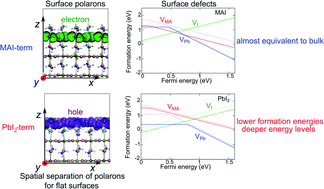Charge localization and trapping at surfaces in lead-iodide perovskites: the role of polarons and defects†
Abstract
Surfaces and grain boundaries play a fundamental role in charge transport, localization and trapping in polycrystalline thin films of metal halide perovskites. Comprehension of the phenomena occurring at the surface is thus crucial to increase solar cell efficiency and, most importantly, temporal stability. We investigate charge localization and trapping at the surface of the prototypical MAPbI3 perovskite through advanced electronic-structure calculations, considering different surface terminations. Both MAI- and PbI2-terminated surfaces exhibit a clear spatial separation of hole and electron polarons, while a MAI-vacant surface induces charge localization at under-coordinated lead atoms. Notably, the PbI2-terminated surface is sensitive to surface defects, which may either act as recombination centres or inhibit charge transfer at the surface, while the MAI-terminated surface is comparably more defect tolerant. We thus suggest that perovskite growth under MAI-rich conditions should be beneficial to limit surface recombination, while the synthesis of MAPbI3 in a PbI2-rich environment should be accompanied by surface passivation strategies to counteract the negative impact of surface defects.



 Please wait while we load your content...
Please wait while we load your content...